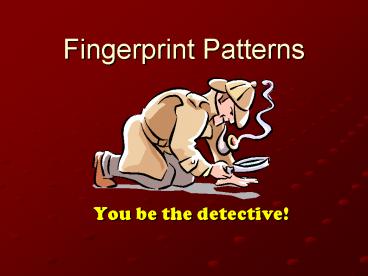Fingerprint Patterns - PowerPoint PPT Presentation
1 / 19
Title:
Fingerprint Patterns
Description:
A fingerprint is an impression of the friction ridges of all or any part of the finger. ... Print Facts ... In 2006, fingerprint sensors gained popularity in ... – PowerPoint PPT presentation
Number of Views:257
Avg rating:3.0/5.0
Title: Fingerprint Patterns
1
Fingerprint Patterns
- You be the detective!
2
The Basics
- A fingerprint is an impression of the friction
ridges of all or any part of the finger. - A friction ridge is a raised portion of the
epidermis on the palm and fingers or sole and
toes skin, consisting of one or more connected
ridge units of friction ridge skin. - These ridges are sometimes known as "dermal
ridges" or "dermal papillae".
3
Print Facts
- Fingerprints may be deposited in natural
secretions from the glands present in friction
ridge skin (secretions consisting primarily of
water) - They may be made by ink or other contaminants
transferred from the peaks of friction skin
ridges to a relatively smooth surface such as a
fingerprint card.
4
Reliability of fingerprinting as an
identification method
- Fingerprints collected at a crime scene, or on
items of evidence from a crime, can be used in
forensic science to identify suspects, victims
and other persons who touched a surface. - No two fingerprints have ever been found
identical in many billions of human and automated
computer comparisons. - Fingerprints are the very basis for criminal
history foundation at every police agency.
5
Fingerprints old school?
- Is claimed to outperform DNA and all other human
identification systems to identify more
murderers, rapists and other serious offenders
(fingerprints are said to solve ten times more
unknown suspect cases than DNA in most
jurisdictions).
6
Print History
- The discovery of fingerprints has been widely
attributed to a 19th century scientist named
Francis Galton. - An ancient Chinese custom includes using the
fingerprint to sign legal documents .
7
- Galton's proposal that "no two fingerprints are
identical" changed the world of forensic science
forever. - In order for fingerprinting to be useful in
forensic identification, a method of sorting and
classifying them would be necessary.
8
Fingerprint Locks
- In the 2000s, electronic fingerprint readers were
introduced for security applications such as
identification of computer users (log-in
authentication). - However, early devices have been discovered to be
vulnerable to quite simple methods of deception,
such as fake fingerprints cast in gels. - In 2006, fingerprint sensors gained popularity in
the notebook PC market. Built-in sensors in
ThinkPads, and others also double as motion
detectors for document scrolling, like the scroll
wheel.
9
Types of Prints
- Fingerprint impressions fall into three basic
types latent, visible, and the plastic (molded),
prints. - Latent print invisible to the eye.
- Latent prints are formed by sweat
- Even the swiftest of criminals find it difficult
to escape without leaving behind the trace of a
single fingerprint.
10
Types of Prints Continued
- Fingers stained with blood or ink found can form
visible prints. - Plastic prints are quite easy to read because
they make an impression on a soft surface such as
soap, putty, or wax.
11
LOOPS
- Loops constitute between 60 and 70 per cent of
the patterns - One or more of the ridges enters on either side
of the impression, recurves, touches or crosses
the line of the glass running from the delta to
the core
12
RADIAL/ULNAR LOOPS
- Depends on the way the loop travels
- Obviously to make the distinction between these
two types of loops you have to know on which hand
they appear
13
WHORLS
- Any fingerprint pattern which contains 2 or more
delta's will be a whorl pattern.
14
Types of Whorls
A
O
S
CENTRAL DOUBLE LOOP
ACCIDENTAL POCKET
15
CENTRAL POCKET WHORLS
- Notice the inner area of the pattern, that is the
area which tends to form a circle?
16
DOUBLE LOOP WHORLS
- Looks like a ying yang symbol in the centre of
the whorl
17
ARCHES
- Arches represent only about 5 per cent of the
fingerprint patterns encountered. In arch
patterns, the ridges run from one side to the
other of the pattern, making no backward turn.
There is ordinarily no delta.
18
COMPOSITES
- Composites include patterns in which combinations
of the tented arch, loop and whorl are found in
the same print, also patterns where the majority
of ridges are loops and a few ridges at the
centre or side are whorls. These are subdivided
into central pocket loops, double loops and
accidentals.
19
Superhero Thumbprints
- At the back of the lab there are ink pads and
worksheets. - You are to ink both your right and left thumbs
and then put them in the appropriate boxes. - Put a star beside any deltas
- that you see
- Identify the pattern of your
- thumbprint.
- Pass into Ms. Clarke and get an
- exit card to complete by the end
- of class.































